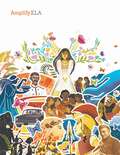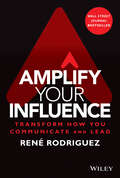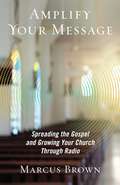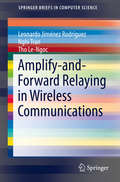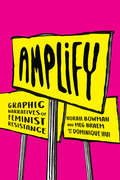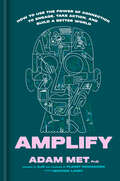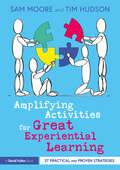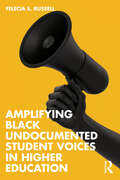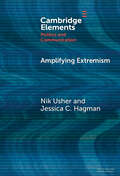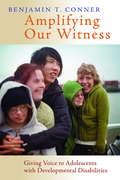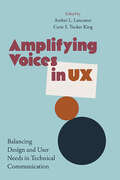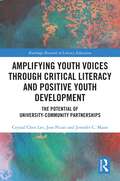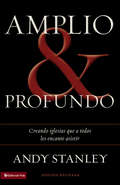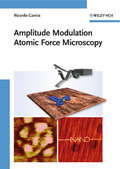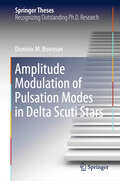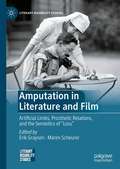- Table View
- List View
Amplify Core Knowledge Language Arts, Kindergarten, Skills 8 Activity Book
by Amplify Core FoundationAmplify Core Knowledge Language Arts, Kindergarten, Skills 8 Activity Book
Amplify Core Knowledge Language Arts, Kindergarten, Skills 8, Sam, Reader
by Amplify Amplify EducationAmplify Core Knowledge Language Arts, Kindergarten, Skills 8, Sam, Reader
Amplify Core Knowledge Language Arts, Kindergarten, Skills 9 Activity Book
by Amplify Core FoundationAmplify Core Knowledge Language Arts, Kindergarten, Skills 9 Activity Book
Amplify Core Knowledge Language Arts, Kindergarten, Skills 9, Zack and Ann, Reader
by Amplify Amplify EducationAmplify Core Knowledge Language Arts, Kindergarten, Skills 9, Zack and Ann, Reader
Amplify Core Knowledge Language Arts, Kindergarten, Skills Picture Reader
by Amplify Core FoundationAmplify Core Knowledge Language Arts, Kindergarten, Skills Picture Reader
Amplify ELA Grade 6
by AmplifyAmplify ELA is a core program designed to respond to the distinct challenges and opportunities faced by middle school students and teachers. The program helps teachers ensure that skills are taught, standards are covered, and the test is prepped—and it does this work in the background so that teachers can spend their time bringing the text to life and providing each student the right instruction at the right time.
Amplify Your Influence: Transform How You Communicate and Lead
by Rene RodriguezApply the latest advances in neuroscience to your real-world persuasion and influence strategies for immediate results In Amplify Your Influence: Transform How You Communicate and Lead, celebrated keynote speaker, trainer and leadership coach Rene Rodriguez delivers an eye-opening roadmap to using applied neuroscience to improve readers’ communication ability, critical thinking, cultural awareness, and leadership skills. Based in the author’s proprietary AMPLIFII system and methodologies he has taught to over 100,000 participants around the world, the book offers practical tips, useful frameworks, guided practice, and simple application exercises to help readers create new and lasting behaviors that effect change in their life and work. Amplify Your Influence shows leaders how to: Leverage various human motivators for positive outcomes and results Frame and communicate their ideas in a way that encourages engagement and gets an active response Intentionally choose a communication style based on their influence objective Perfect for executives, managers, sales professionals, and other business leaders, Amplify Your Influence is required reading for anyone seeking to improve their ability to effect change in the people around them, whether they’re in the office, the boardroom, the classroom, or at home.
Amplify Your Message: Spreading the Gospel and Growing Your Church Through Radio
by Marcus BrownAnd (Jesus) said to them, 'Go into all the world and proclaim the Gospel to the whole creation.' Mark 16:15 (ESV) The need for proclaiming the Good News to the world has never been greater. Recent statistics reveal that 63% of Americans go to church less than once a month, and almost half of that group never set foot inside a church. That puts us in a dilemma. If those in need of the message of salvation through Jesus Christ aren’t coming to our churches, how do we reach them? How then will they call on him in whom they have not believed? And how are they to believe in him of whom they have never heard? And how are they to hear without someone preaching? And how are they to preach unless they are sent? Romans 10:14-15 (ESV) Salem Media Group has an answer: Radio. Nielsen Media Research—the world’s leader in media data—has found “traditional AM/FM terrestrial radio still retains its undiminished appeal for listeners; 91% of Americans, aged 12 and older, listen to this form of radio.” When radio is amplified with new technology, its reach is powerful. When matched with biblical preaching and teaching, God’s Kingdom expands. Not only are the lost led to salvation, they are drawn to your church, putting them where they need to be to become disciples. This book details how a local Salem Media radio platform can partner with your church to fulfill the Great Commission and grow your ministry. From the “why” to the “how,” we give you everything you need to prayerfully consider this opportunity to pierce the darkness in your community with the Light of the World.
Amplify-and-Forward Relaying in Wireless Communications (SpringerBriefs in Computer Science)
by Tho Le-Ngoc Leonardo Jiménez Rodríguez Nghi TranThis SpringerBrief explores the advantage of relaying techniques in addressing the increasing demand for high data rates and reliable services over the air. It demonstrates how to design cost-effective relay systems that provide high spectral efficiency and fully exploit the diversity of the relay channel. The brief covers advances in achievable rates, power allocation schemes, and error performance for half-duplex (HD) and full-duplex (FD) amplify-and-forward (AF) single-relay systems. The authors discuss the capacity and respective optimal power allocation for a wide range of HD protocols over static and fading channels. Then, optimal amplification coefficients in terms of achievable rate are presented. Chapters also examine performance with finite constellations, including the error and diversity performance. The brief concludes with a capacity and error performance analysis of the FD relay mode of operation, where the residual self-interference due to FD transmission is explicitly taken into account. Amplify-and-Forward Relaying in Wireless Communications reveals the benefits and challenges of relaying techniques. It is designed for researchers and professionals in wireless communication. This material is also appropriate for advanced-level students in electrical engineering and computer science.
Amplify: Graphic Narratives of Feminist Resistance
by Meg Braem Norah BowmanIn this highly original text – a collaboration between a college professor, a playwright, and an artist – graphic storytelling offers a unique way for readers to understand and engage with feminism and resistance in a more emotionally resonant way. Issues of performativity, gender roles, intersectionality, and privilege are explored in seven beautifully illustrated graphic vignettes. From Pussy Riot to the Women of the Black Panthers, and from Leymah Gbowee to Harsha Walia, each vignette highlights unique moments and challenges in the struggle for feminist social justice. Brief introductions provide enough background context for the uninitiated, while further readings offer opportunities for those who wish to learn more. Finally, carefully crafted discussion questions help readers probe the key points in each narrative while connecting specific stories to more general concepts in gender studies and feminist theory.
Amplify: How to Use the Power of Connection to Engage, Take Action, and Build a Better World
by Adam Met PhDA blueprint for boosting your activism and building support for the causes you care about, featuring fan-building tactics from the music industry and the voices of today&’s most passionate change-makers&“This book shines a light on a wealth of new strategies to help reach people in ways that are both authentic and resonant.&”—John KerryFrom stadium acts to indie singer-songwriters, musicians have pioneered ways of sparking passion, building awareness, and catalyzing engagement. Now imagine if social movements—from the fight to protect the planet to campaigns promoting global health or LGBTQIA+ rights—had the same fervent support as your favorite artists.Adam Met, climate advocate, educator, and member of the multiplatinum band AJR, gained firsthand experience growing an audience from the ground up as the band progressed from playing in living rooms to selling out arenas. With award-winning journalist Heather Landy, Met shows how to apply fan-building strategies to social movements in exciting, inventive ways. Amplify is a playbook for developing passionate supporters (i.e., fans) utilizing the art and science of engagement, collaboration, and authentic connection, with tactics that will inspire people to carry your message to the world and spur others to act.Amplify&’s innovative tool kit will help you find your voice and maximize your impact in the world of social progress to create the change you want to see.This movement-building manifesto includes cutting-edge research and strategies from today&’s most effective organizers, engagers, and thinkers, including extensive interviews with • Adam Grant (Wharton professor) on embracing disagreement within a movement• Christiana Figueres (Paris Climate Agreement architect) on finding a path to solutions• Andrew Yang (former U.S. presidential candidate) on becoming the front person for your ideas• David Hogg (March for Our Lives co-founder) on the challenges of building a youth-led movement• Chi Ossé (youngest-ever NYC council member) on working outside the box but within the system• Sue Doster (NYC Pride co-chair) on keeping movements nimble and relevant• Glenn Beck (conservative commentator) on finding common ground• Jim Gaffigan (comedian) on setting and achieving goals• Bill Nye (scientist and entertainer) on communication that connects with people• Ben Folds (musician) on staying in sync with your audience• Jamie Drummond (ONE Campaign co-founder) on the beauty of purposeful compromise• Enongo Lumumba-Kasongo (hip-hop scholar) on the intersection of activism and history• Wendy Laister (Duran Duran manager) on harnessing the energy of live events• Clyde Lawrence and Jordan Cohen (of the band Lawrence) on pressing your argument• MAX (musician) on the power of collaboration• Sam Hollander (songwriter) on aligning different perspectives• Astro Teller (co-founder of Alphabet&’s X division) on taking moonshots
Amplifying Activities for Great Experiential Learning: 37 Practical and Proven Strategies
by Tim Hudson Sam MooreThis book provides proven practical strategies and approaches to help you run your existing learning activities in new and more effective ways. It shows how by using distinct and deliberate strategies, teachers and trainers can guide and maximise the learning and development that their activity provides. The 37 ideas can all be used independently and are appropriate for children and young people of different ages and abilities and can be used in many different environments including outside, inside, classrooms, sports pitches and wilderness, and more. Each strategy is presented on a double page spread with illustrations and includes: Issues this strategy will help address How to implement this strategy The strategy in action, with examples from a wide selection of educational fields How this strategy helps maximise learning Any pitfalls to be wary of Other similar strategies to consider Aimed at teachers, outdoor and adventure instructors, sports coaches, drama and music teachers and science educators, this is valuable reading for all educators wanting to deliver exciting experiential learning activities.
Amplifying Black Undocumented Student Voices in Higher Education
by Felecia S. RussellThis book centers a qualitative study exploring the experiences of 15 Black undocumented students and the author’s own experiences as a Black DACA (Deferred Action for Childhood Arrivals) recipient, highlighting the invisibility and lack of belonging Black undocumented students face in the undocumented community and the United States at large.Access and success within higher education for undocumented students cannot be achieved unless those implementing policies understand the full context of the community. Through both an interpretative phenomenological approach and biographical memoir, this volume makes meaning of the experiences of undocuBlack students, a group who do not often see themselves being represented in the immigrant narrative. It argues that without visibility, undocuBlack students are rarely the beneficiaries of advocacy and become targets of overcriminalization. The stories told here examine the intersection of race and identity in determining positioning within society, with the goal of contributing awareness and promoting more inclusive practices among higher education communities.This text offers an important new perspective for faculty and administrators, policymakers, upper-level undergraduate and graduate students, as well as general readers with an interest in Black and immigrant narratives and the undocumented experience as an academic subject.
Amplifying Extremism: Small Town Politicians, Media Storms, and American Journalism (Elements in Politics and Communication)
by Nikki Usher Jessica Cherese HagmanWithin a week, a no-name Republican state representative from a town of 384 people in Illinois catapulted from obscurity to a prime-time appearance on Fox News' Ingraham Angle. This newly empowered politician, Darren Bailey, would go on to steer the pro-business Republican party in Illinois toward extremism. Democratic backsliding emerges across all levels of politics, but the threats posed by small-town politicians have been overshadowed by national-level politicians. This microstudy of a single politician's debut in the public eye showcases a novel approach to media corpus construction that combines proprietary and open databases, aggregated search tools, and targeted searching, and includes local, regional, and national news across digital-first, radio, news publishers, broadcast and cable television, and social media. The Element provides unique insights into how American journalism creates space for small-town extremists to gain power, especially given declines in local news.
Amplifying Informal Science Learning: Rethinking Research, Design, and Engagement
by Judy Diamond Sherman RosenfeldThis collection explores the broad landscape of current and future out-of-school science learning environments. Written by leading experts and innovators in informal science learning, these thoughtful and critical essays examine the changing nature of informal institutions such as science museums, zoos, nature centers, planetariums, aquaria, and botanical gardens and their impact on science education. The book examines the learning opportunities and challenges created by community-based experiences including citizen science, makerspaces, science media, escape rooms, hobby groups, and gaming. Based on current practices, case studies, and research, the book focuses on four cross-cutting themes – inclusivity, digital engagement, community partnerships, and bridging formal and informal learning – to examine how people learn science informally. The book will be of interest to STEM (science, technology, engineering and math) educators – both in and out of school – designers of science and experiential education programs, and those interested in building STEM learning ecosystems in their communities.
Amplifying Our Witness: Giving Voice to Adolescents with Developmental Disabilities
by Benjamin T. ConnerNearly twenty percent of adolescents have developmental disabilities, yet far too often they are marginalized within churches. Amplifying Our Witness challenges congregations to adopt a new, practice-centered approach to congregational ministry -- one that includes and amplifies the witness of adolescents with developmental disabilities. Replete with stories taken from Benjamin Conner's own extensive experience with befriending and discipling adolescents with developmental disabilities, Amplifying Our Witness Shows how churches exclude the mentally disabled in various structural and even theological waysStresses the intrinsic value of kids with developmental disabilitiesReconceptualizes evangelism to adolescents with developmental disabilities, emphasizing hospitality and friendship.
Amplifying Voices in UX: Balancing Design and User Needs in Technical Communication (SUNY series, Studies in Technical Communication)
by Amber L. Lancaster; Carie S. Tucker KingThe field of technical and professional communication is young, and research related to it—and specifically usability—is constantly growing. Usability and user-experience researchers are broadening research into studies involving social issues, accessibility, reconciliation, and user advocacy. Amplifying Voices in UX explores the theme of balance in design and UX in three main areas: curriculum design that includes empathy, service learning, and design justice; design and balance for effective medical and health communication; and design to create balance in labor, social, civic, and political movements.
Amplifying Your Fans: A Five-Step Plan for Successful Word-Of-Mouth Marketing Using Social Technologies
by Josh Bernoff Ted SchadlerDoes your product or service have fans? Now that your customers are communicating with others-perhaps thousands of them at once-on their mobile devices, you need to find customers who love you, and then let them spread the word. In other words, you need to build your fan base and let it go to work for you. In this chapter, authors Josh Bernoff-coauthor of "Groundswell"-and Ted Schadler introduce a five-step method for amplifying positive word of mouth: 1) Gather and analyze customer perspectives; 2) Respond to your customers; 3) Enable your customers to talk about you; 4) Amplify your customers' voices; and 5) Make changes based on what you've learned. Through real-life examples from Microsoft, the NHL, and Genzyme, you'll understand why word of mouth is one of the hottest trends in marketing. This chapter was originally published as Chapter 6 of Empowered: Unleash Your Employees, Energize Your Customers, and Transform Your Business
Amplifying Youth Voices through Critical Literacy and Positive Youth Development: The Potential of University-Community Partnerships (Routledge Research in Literacy Education)
by Crystal Chen Lee Jose Picart Jennifer C. MannThis book explores the transformative power of critical literacy in fostering youth engagement through university-community partnerships. It is based on a six-year study by The Literacy and Community Initiative (LCI) at North Carolina State University.This book examines the potential, possibilities, and challenges of using critical literacy in university-community partnerships to amplify youth voices. Through the LCI program, youth in four community-based organizations completed a critical literacy curriculum, published their writings in a book, and participated in public readings to engage and lead their communities. The authors draw on data from semi-structured individual interviews, focus groups, youth narratives, and socio-emotional surveys across four unique youth populations. The youth populations involved collaborations with youth of color in urban communities, Latine immigrant and second-generation youth, girls in foster care and high-risk situations, and youth from immigrant and refugee backgrounds. Results of the study suggest that after engaging in the LCI critical literacy program, youth demonstrated improved literacy skills, enhanced social-emotional well-being, and increased community leadership and self-advocacy. Presenting a novel theoretical framework for the effective use of critical literacy to promote positive youth development in conjunction with first-hand insights into the successful development and sustainment of university-community research partnerships, this book ultimately provides a unique insight into how critical literacy and successful university-community partnerships can combine to result in powerful support for underserved culturally and linguistically diverse youth.This book will appeal to scholars, educators, and practitioners with interests in critical literacy, positive youth development studies, and adolescent research.
Amplio y profundo: Edificando iglesias de las que todos quisieran ser parte
by Andy StanleySi tu equipo está más preocupado por las personas que ALCANZA, que por las que CONSERVA, Amplio y profundo será para ustedes un recurso que consultarán una y otra vez. Con una sinceridad y una transparencia sorprendentes, Andy Stanley explica cómo una de las iglesias más grandes de los Estados Unidos comenzó con un divorcio famoso y la división de una iglesia. En su libro te presenta su estrategia para atraer a la iglesia a las personas que no tienen iglesia y asegurarse de que regresen… con sus amigos. Conoce las metas y el funcionamiento de North Point Community Church, en Alpharetta, Georgia. Por vez primera, Andy Stanley explica su estrategia para predicarle a una audiencia «doble»: personas que ya son creyentes, y visitantes que no tienen aún iglesia, y hasta es posible que piensen de una manera cínica con respecto al cristianismo. El autor presenta en detalle el modelo de formación espiritual de North Point: los cinco Catalizadores de la Fe. Los líderes responsables de programar los cultos sentirán gran interés en lo que él llama «los tres ingredientes esenciales para crear un ambiente irresistible». Entendiendo como nadie por experiencia propia la situación de las iglesias que quieran hacer la transición hacia un modelo más aproximado al suyo, Andy Stanley explica en detalle la manera de realizar esta transición. Más que un libro, Amplio y profundo es un atractivo manual de fácil y agradable lectura nacido de la experiencia y la labor en equipo guiada por el Espíritu Santo, que pondrá a pensar y actuar a todo pastor o líder de ministerio que necesite un nuevo enfoque de las Escrituras y de la vida de las iglesias para hacer la parte que le corresponde en la Gran Comisión de Cristo.
Amplitude Modulation Atomic Force Microscopy
by Ricardo GarcíaFilling a gap in the literature, this book features in-depth discussions on amplitude modulation AFM, providing an overview of the theory, instrumental considerations and applications of the technique in both academia and industry. As such, it includes examples from material science, soft condensed matter, molecular biology, and biophysics, among others. The text is written in such a way as to enable readers from different backgrounds and levels of expertise to find the information suitable for their needs.
Amplitude Modulation of Pulsation Modes in Delta Scuti Stars (Springer Theses)
by Dominic M. BowmanThis outstanding thesis by Dominic Bowman provides a thorough investigation of long-standing questions as to whether amplitude modulation is astrophysical, whether it offers insights into pulsating stars, and whether simple beating of modes with stable amplitudes is unrecognised because of a lack of frequency resolution. In this thesis, the author studied a uniform sample of 983 delta Scuti stars—the most common type of main-sequence heat engine pulsator—that were observed nearly continuously for 4 years at stunning photometric precision of only a few parts per million by the Kepler space mission. With no mission planned to supersede the Kepler 4-year data set, this thesis will stand as the definitive study of these questions for many years. With revolutionary photometric data from the planet-hunting Kepler space mission, asteroseismic studies have been carried out on many hundreds of main-sequence solar-type stars and about 10,000 red giants. It is easy to understand why those stochastically driven stars have highly variable amplitudes. Over much of the rest of the Hertzsprung–Russell (HR) diagram, stellar pulsations are driven by heat mechanisms, which are much more regular than the stochastic driving in solar-like pulsators. Yet for decades, amplitude and frequency modulation of pulsation modes have been observed in almost all types of heat-driven pulsating stars. The author shows that the amplitude and frequency modulation are astrophysical, and he has investigated their implications and prospects to provide new insights into the delta Scuti stars and the many other types of heat-engine pulsators across the HR diagram.
Amputation in Literature and Film: Artificial Limbs, Prosthetic Relations, and the Semiotics of "Loss" (Literary Disability Studies)
by Maren Scheurer Erik GraysonAmputation in Literature and Film: Artificial Limbs, Prosthetic Relations, and the Semiotics of “Loss” explores the many ways in which literature and film have engaged with the subject of amputation. The scholars featured in this volume draw upon a wide variety of texts, both lesser-known and canonical, across historical periods and language traditions to interrogate the intersections of disability studies with social, political, cultural, and philosophical concerns. Whether focusing on ancient texts by Zhuangzi or Ovid, renaissance drama, folktales collected by the Brothers Grimm, novels or silent film, the chapters in this volume highlight the dialectics of “loss” and “gain” in narratives of amputation to encourage critical dialogue and forge an integrated, embodied understanding of experiences of impairment in which mind and body, metaphor and materiality, theory and politics are considered as interrelated and interacting aspects of disability and ability.

